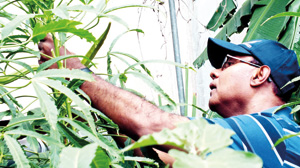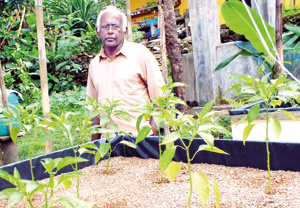Gardens of rich, nutritious vegetables on soil-less surroundings on your balcony!
View(s):Of the 7 billion world population, around 2 billion are either suffering from malnutrition or under nutrition and one in three children die of hunger in Asia. These deaths and deficiencies could be mitigated through agriculture, growing more and providing sufficient quantities of food to everybody. A new concept called hydroponic gardening may be the answer to these global issues.

Dr. Susil Liyanarachchi and his wife, Janaki Saparamadu
In Sri Lanka, Susil Liyanarachchi and his wife Janaki Saparamadu with the assistance of the National Science Foundation (NSF), three universities – Colombo, Open and Peradeniya – and several others are on a journey to simplify and popularise hydroponic gardening – home gardening which is cheap, labour saving and could be grown even in a little space.
Hydroponics is a subset of hydro-culture and is a method of growing plants using mineral nutrient solutions, in water, without soil. Terrestrial plants may be grown with their roots in the mineral nutrient solution only or in an inert medium, such as perlite or gravel and in Sri Lanka paddy husk is used for this purpose. This method was introduced to Sri Lanka by the Agricultural Department in 1980.
Dr. Liyanarachchi’s basic degree is from Russia and he has a PhD in Agricultural Biology while he has done his post-doctoral studies at the Belgian Catholic University, Leuven. A researcher, he has worked in several institutions and has been working in the Intermediate Technology Group (ITDG) which is run by E.F. Schumaker, an Economist from the UK, while Ms. Saparamadu is a Senior Lecturer in Chemistry at the Open University.
The Business Times (BT) met the Sri Lankan researcher at his residence at Pietersz Place, Kohuwala where housing is getting congested for want of space. The residence is a two storied building and on the top floor in the back there is a tiny portion of concreted space which is covered with a variety of vegetable plants – Okra (Bandakka), Long beans (Me-karal) Kankung, Capsicum, etc. He has been involved in this tedious exercise for the last six years that could, if done perfectly, help benefit the whole nation.

Okra plant.
The trial production rates obtained in Sri Lanka is as follows – tons per hectare – under Hydroponics method and on soil: Tomato 60-20; Brinjal 104-25; Bitter gouard 37-20, Okra 31-15 and Cabbage 109-40.They have evolved a simplified method suited to urban households where the gardening space is limited. Though the method is specific to urban households, different hydroponic methods are used the world over at large scale which has the benefit of bigger yields in lesser land.
Dr. Liyanarachchi also took the BT accompanied by a female Scientific Officers of NSF to Rukmala, Pannipitiya to show one of the successful vegetable plots sponsored by them and maintained by A.D. Chitrananda, a retired police officer.He said he obtained a grant from the USAID to visit Mexico and study the system and on his return launched a pilot project with the help of the Colombo University.
To grow plants under this method there should be grow boxes which can be made out of wood, rigiform or plastic material. Instead of soil rice husk and river sand is used. He said since plants need water, solar energy, air and 13 other elements to grow these elements have to be soluble in water for the plants to absorb them, he stressed.
Ms. Saparamadu undertook the research on a low cost nutrient solution in collaboration with three universities – Colombo, Open and Peradeniya. She was able to evolve the suitable nutrient solution for Sri Lanka and the couple is now on several pilot projects with individuals and farmer groups with the support of various agencies.

A.D Chitrananda at his home garden
The Scientific Officer, NSF explained that they have assisted the project to conduct a kind of social assessment to understand the marketability of this technology, particularly in urban areas. She told the BT that they worked closely with individuals and families in the urban areas. She indicated that they are now in the process of commercialising this simplified hydroponics system in Sri Lanka.
This concept could be traced back to the era of hanging gardens in the city of ancient Babylon and its use expanded with the outbreak of the 2nd World War in 1939, he pointed out and added that there are hundreds of methods of hydroponics systems.
The NSF while monitoring the project is also trying to find entrepreneurs to fit into the project to commercialise and to establish a place in the market. Dr. Liyanarachchi could be contacted at susilliyana@gmail.com


